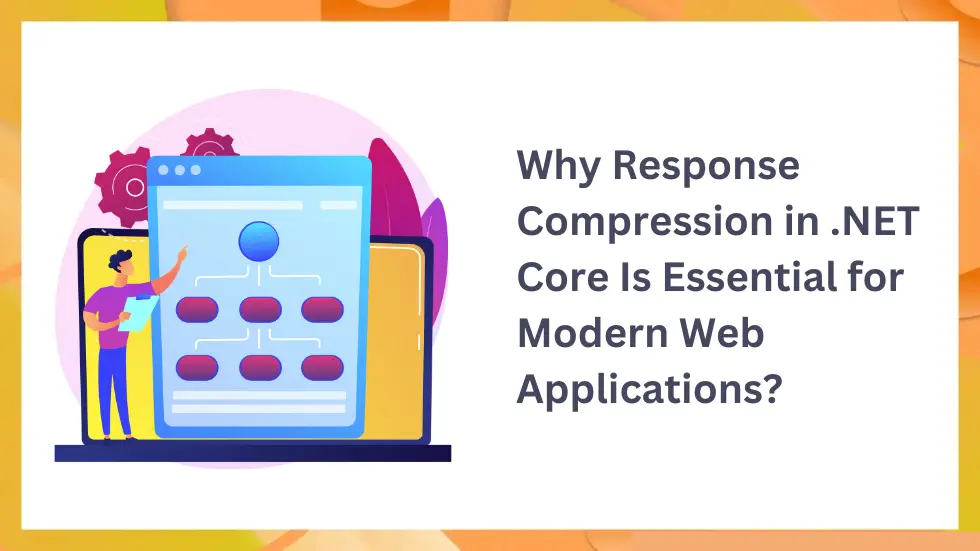In the era of digital acceleration, users expect lightning-fast applications—whether on mobile or desktop, low-bandwidth or high-speed networks. For startups, enterprises, and tech-driven companies building on .NET Core, one low-effort, high-impact optimization is response compression.
In this blog, we’ll explore what response compression in .NET Core is, how it works, and why it’s essential for enhancing web application performance, improving scalability, and reducing operational costs.
Why Application Performance Matters
Application speed is directly tied to user experience and business outcomes. Slow response times can result in higher bounce rates, lower engagement, and missed opportunities.
Key reasons to prioritize performance:
- Better Core Web Vitals and SEO rankings
- Faster user interactions and higher conversions
- Reduced cloud bandwidth and hosting costs
- Improved app scalability and infrastructure efficiency
By implementing response compression in .NET Core, businesses can address these challenges without overhauling their architecture.
What Is Response Compression in .NET Core?
Response compression is a performance optimization technique that reduces the size of HTTP responses before they’re sent to the client. This results in:
- Smaller payload sizes
- Faster data transfer
- Better load times
.NET Core simplifies this process using middleware, making it easy for developers to compress responses automatically without extensive code changes.
Core Benefits of Using Response Compression in .NET Core
Implementing response compression in .NET Core delivers multiple benefits, especially for high-traffic or API-driven applications:
- ✅ Reduced Bandwidth Usage
Smaller files mean less data transfer, which directly lowers network and cloud costs.
- ✅ Faster Page Loads and API Calls
Compressing large JSON, XML, or HTML responses significantly cuts load times.
- ✅ Improved User Experience
Faster loading times enhance usability, particularly on slower networks.
- ✅ Better Search Engine Performance
Google favors sites with quick loading times, giving you a competitive SEO edge.
- ✅ Lower Server Load
Less data sent = fewer server resources consumed, improving overall scalability.
Supported Compression Algorithms in .NET Core
.NET Core provides built-in support for two major compression algorithms:
- Gzip: A widely supported and fast option that works well across most browsers and clients.
- Brotli: A newer and more efficient compression method, ideal for text-based content like HTML, CSS, and JSON.
You can enable both algorithms to ensure optimal performance across all user environments.
How to Implement Response Compression in .NET Core
Here’s a simple way to enable response compression using middleware in ASP.NET Core:
csharp
CopyEdit
builder.Services.AddResponseCompression(options =>
{
options.EnableForHttps = true;
options.Providers.Add<GzipCompressionProvider>();
options.Providers.Add<BrotliCompressionProvider>();
});
app.UseResponseCompression();
This code ensures that all eligible HTTP responses are compressed, especially when served over HTTPS.
Real-World Use Cases and Scenarios
Response compression in .NET Core is valuable in several enterprise-grade scenarios:
- 📊 RESTful APIs serving large datasets (JSON/XML)
- 🌍 International apps targeting users on limited-bandwidth networks
- 📱 Mobile-first web applications requiring fast response times
- ☁️ Cloud-native services aiming to optimize compute and data transfer costs
- 🧾 SaaS platforms delivering dynamic reports or dashboards
Performance Metrics: What the Data Says
Studies show that compressed responses can reduce payload sizes by up to 90%, particularly for text-heavy content like HTML, JSON, or CSS.
Real-world benefits include:
- 40–60% improvement in load times
- Enhanced Lighthouse and WebPageTest performance scores
- Reduced AWS/GCP/Azure data egress costs for API-heavy applications
Best Practices for Response Compression in .NET Core
To get the most out of this feature, follow these expert tips:
- 🔐 Enable compression over HTTPS only to avoid exposing vulnerabilities.
- ⚙️ Choose algorithms based on content type — Brotli for text, Gzip for general use.
- 📊 Benchmark before and after using tools like Lighthouse, GTMetrix, or WebPageTest.
- 🧠 Monitor CPU usage — compression requires server processing.
- 📦 Use caching in combination with compression for maximum speed.
Conclusion
If you’re building or scaling enterprise-grade applications using .NET Core, response compression is a simple yet powerful technique to boost performance. From faster response times and better SEO to reduced costs and improved scalability, the benefits are clear.
With built-in middleware support and modern compression algorithms, implementing response compression in .NET Core should be a priority for any development team aiming for speed, efficiency, and growth.
Additional Resources:
